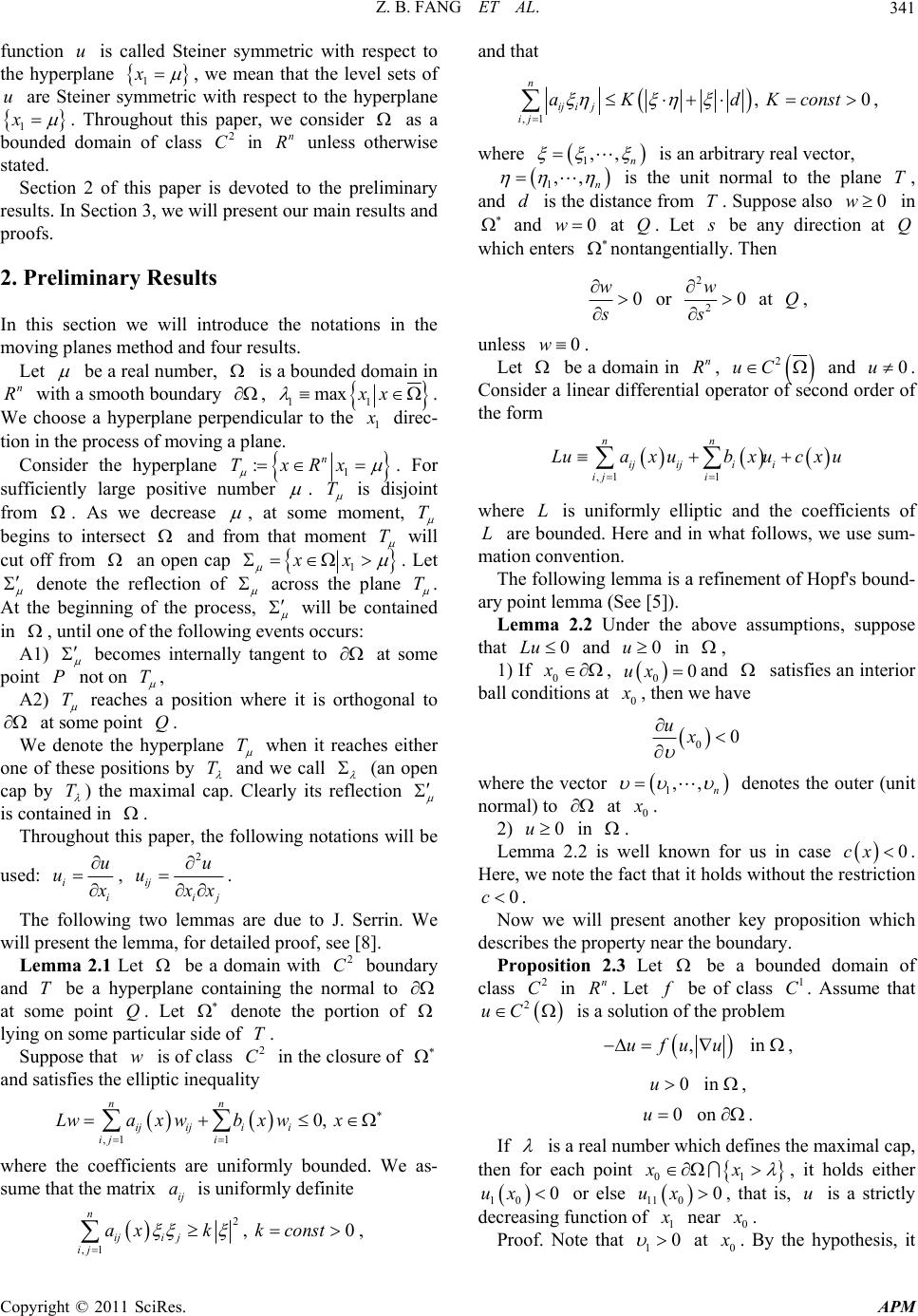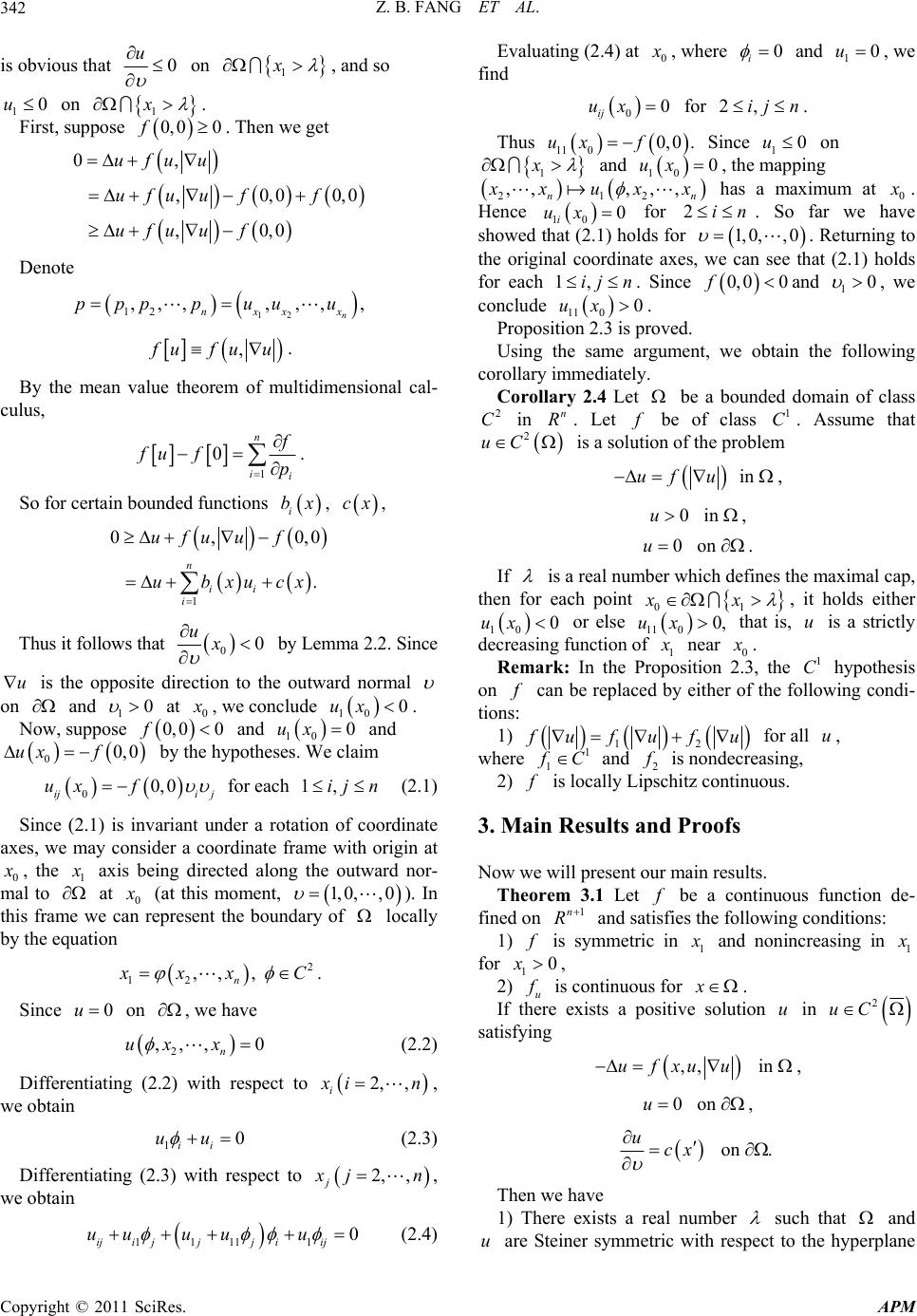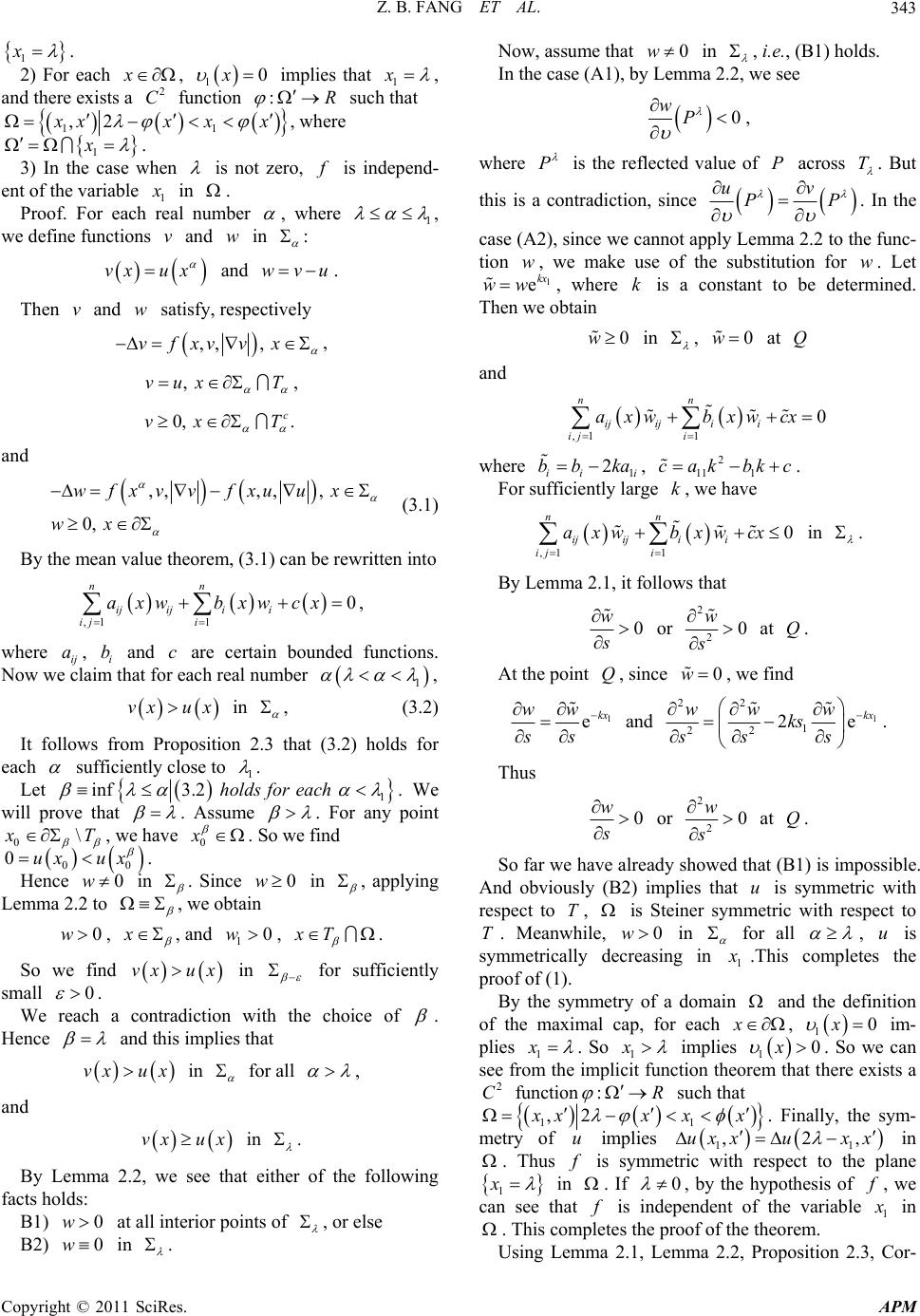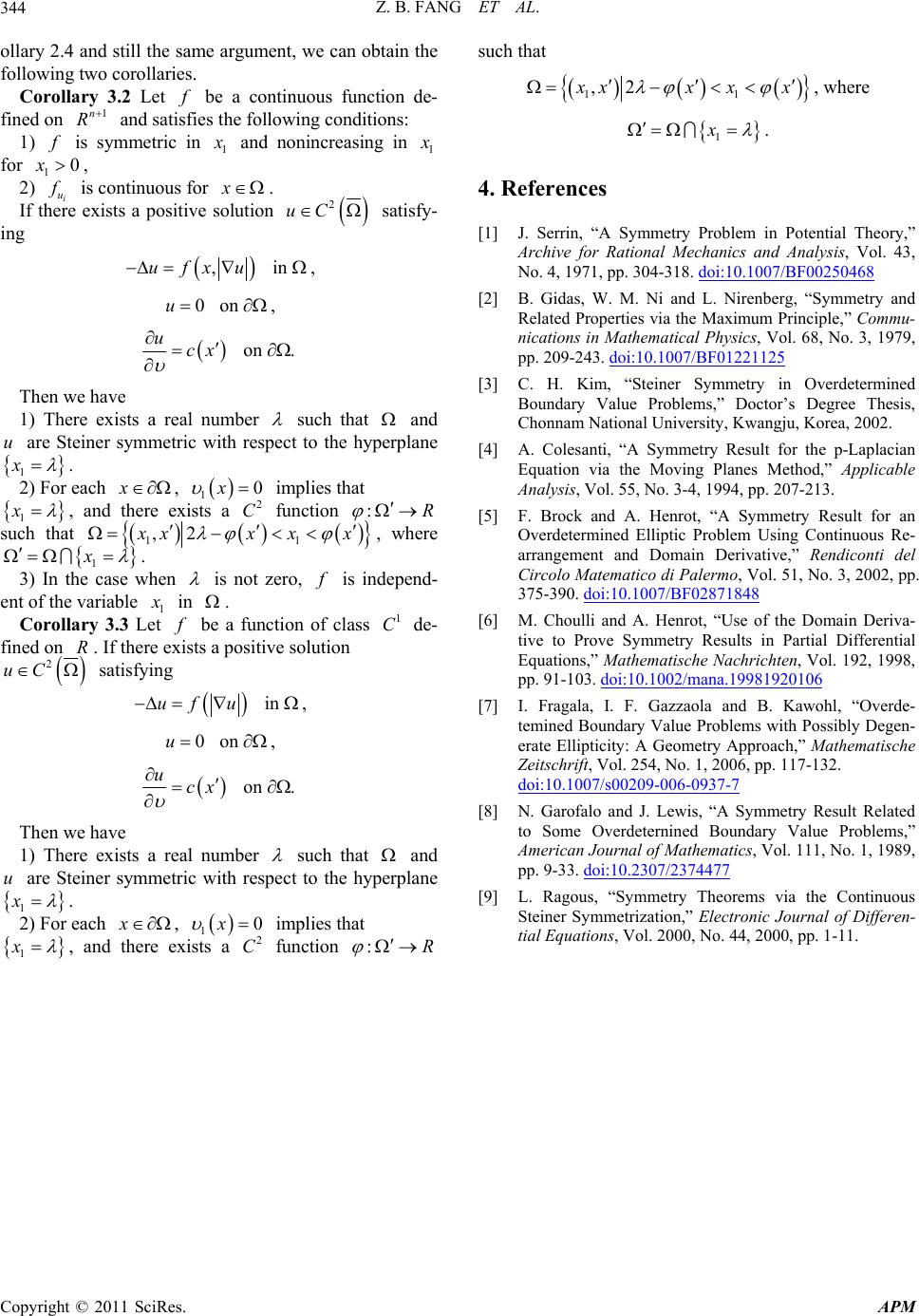 Advances in Pure Mathematics, 2011, 1, 340-344 doi:10.4236/apm.2011.16061 Published Online November 2011 (http://www.SciRP.org/journal/apm) Copyright © 2011 SciRes. APM Some Steiner Symmetry Results in Overdetermined Boundary Va lue Pr oblem* Zhongbo Fang, Anna Wang School of Mathemat i cal Sci ences, Ocean University of China, Qingdao, Chi na E-mail: fangzb7777@hotmail.com Received June 17, 2011; revised August 2, 2011; accepted August 10, 2011 Abstract In this paper, we use the moving planes method to prove that the domain Ω and the solution u are Steiner symmetric if u is a positive solution of the overdetermined boundary value problem in Ω. Keywords: Steiner Symmetry, Moving Planes Method, Overdetermined Boundary Value Problem 1. Introduction We will present some symmetry results in overdeter- mined boundary value problem ,,0 in ufxuu 0 on u on ucx where 1,n xx R , 23 ,,, n xx x and is the outward unit normal to . Here is a bounded domain of class in , n R 2 C is a function of class and satisfies certain conditions, is a differenti- able function. Obviously the constant normal derivative of on is a special case of this problem. 1 Cc u For the motion of a viscous incompressible fluid moving in straight parallel streamlines through a pipe with planar section or the torsion of a solid straight bar of given cross section , both of them can be de- scribed by the following overdetermined problem 1 in u 0 on u on uconst where is a bounded domain of class in such that there exists a function satisfying the above problem, and 2 Cn R u is the unit normal to . Using the moving planes method, J. Serrin proved that if the above problem has a solution in u 2 C, then must be a ball. For more detail, see [1]. Later there are many au- thors who investigated the overdetermined the problem. B. Gidas, W. M. Ni and L. Nirenberg proved symmetry of positive solutions of elliptic equations under the Dirichlet boundary condition via moving planes method, in ufu 0 on u See [2]. The paper [3] extended the result of [2], but it did not contain the gradient. A. Colesanti considered the positive solutions of a more general p-Laplacian equation under the overdetermined conditions which has only one critical point via moving planes method too, 2,0 \ p divuuf uuinP 0 on u 0 on uc . See [4]. Recently there have been found several other new approaches in studying symmetry problem, such as continuous Steiner symmetrization, domain derivatives and some geometry method, see [5-9]. The moving planes method is a classical technique and is very useful in dealing with symmetry problems, so we still use it to extend the results of [2,3] to the overdetermined bound- ary problem containing gradient. We shall prove that and are Steiner symmet- ric with respect to the hyperplane 1 u x for some real number . To be more specifically, a set is Steiner symmetric with respect to the hyperplane 1 x if it is symmetric with respect to the hyper- plane 1 x and convex in the 1 direction. The *The Project-sponsored by SRF for ROCS, SEM.  Z. B. FANG ET AL.341 function is called Steiner symmetric with respect to the hyperplane u 1 x , we mean that the level sets of are Steiner symmetric with respect to the hyperplane 1 ux . Throughout this paper, we consider as a bounded domain of class in unless otherwise stated. 2 Cn R Section 2 of this paper is devoted to the preliminary results. In Section 3, we will present our main results and proofs. 2. Preliminary Results In this section we will introduce the notations in the moving planes method and four results. Let be a real number, is a bounded domain in with a smooth boundary n R , 11 max xx . We choose a hyperplane perpendicular to the 1 direc- tion in the process of moving a plane. Consider the hyperplane 1 :n RxTx . For sufficiently large positive number . T is disjoint from . As we decrease , at some moment, T begins to intersect and from that moment T will cut off from an open cap 1 xx . Let denote the reflection of across the plane T . At the beginning of the process, will be contained in , until one of the following events occurs: A1) becomes internally tangent to at some point not on T P , A2) T reaches a position where it is orthogonal to at some point . Q We denote the hyperplane T when it reaches either one of these positions by T and we call (an open cap by T ) the maximal cap. Clearly its reflection is contained in . Throughout this paper, the following notations will be used: i u i u , 2 ij u ij u x . The following two lemmas are due to J. Serrin. We will present the lemma, for detailed proof, see [8]. Lemma 2.1 Let be a domain with boundary and be a hyperplane containing the normal to 2 C T at some point Q. Let denote the portion of lying on some particular side of . T Suppose that is of class in the closure of w2 C and satisfies the elliptic inequality ,1 ij ij ax w 0, ij x x i w 1 nn i i bLw ij a where the coefficients are uniformly bounded. We as- sume that the matrix is uniformly definite 2 ,1 ij k onst , 0kc n ij i j ax , and that ,1 , 0 n ij ij ij aK dKconst , where 1,, n is an arbitrary real vector, ,, 1n d is the unit normal to the plane T, and is the distance from . Suppose also in T0w and 0w at Q. Let be any direction at which enters Q nontangentially. Then 0 w s or 2 20 w s at Q, unless 0w . Let be a domain in , n R 2 uC and 0u . Consider a linear differential operator of second order of the form ,1 1 nn ijijii ij i Luax ubxucxu where is uniformly elliptic and the coefficients of L are bounded. Here and in what follows, we use sum- mation conventio L n. The following lemma is a refinement of Hopf's bound- ary point lemma (See [5]). Lemma 2.2 Under the above assumptions, suppose that 0Lu and in , 0u 1) If 0 x , 00ux and satisfies an interior ball conditions at 0 , then we have 00 ux where the vector 1,, n denotes the outer (unit normal) to at 0 . 2) in 0u . Lemma 2.2 is well known for us in case 0cx . Here, we note the fact that it holds without the restriction 0c . Now we will present another key proposition which describes the property near the boundary. Proposition 2.3 Let be a bounded domain of class in . Let 2 Cn R be of class . Assume that 1 C uC 2 is a solution of the problem , in ufuu , 0 in u, 0 on u . If is a real number which defines the maximal cap, then for each point 01 xx , it holds either 10 0ux or else 11 00ux 1 , that is, is a strictly decreasing function of u near 0 . Proof. Note that 10 at 0 . By the hypothesis, it Copyright © 2011 SciRes. APM  Z. B. FANG ET AL. 342 is obvious that 0 u on 1 x , and so 10u on 1 x . First, suppose 0, 0f0. Then we get 0, ,0,0 ,0,0 ufuu ufuu ff ufuu f 0,0 Denote 12 12 ,,,,,,, n nxxx ppppuuu , ufuu . By the mean value theorem of multidimensional cal- culus, 1 0 n ii fu fp . So for certain bounded functions , , i bx cx 1 0, . n ii i ufuu f ubxucx 0,0 Thus it follows that 00 ux by Lemma 2.2. Since u is the opposite direction to the outward normal on and 10 at 0 , we conclude 10 0ux . Now, suppose and ux and by the hypotheses. We claim 0, 00 0 f 10 0 00,uxf 00, 0 iji j ux f for each 1, (2.1) ij n Since (2.1) is invariant under a rotation of coordinate axes, we may consider a coordinate frame with origin at 0 , the 1 axis being directed along the outward nor- mal to at 0 (at this moment, 1, 0,, 0 ). In this frame we can represent the boundary of locally by the equation 2 12 ,,, n xx C . Since on , we have 0u 2 ,,, 0 n ux x (2.2) Differentiating (2.2) with respect to 2, , i in, we obtain 10 ii uu (2.3) Differentiating (2.3) with respect to 2, , j jn, we obtain 1111 1 0 iji jjjiij uuu uu (2.4) Evaluating (2.4) at 0 , where 0 i and 10u , we find 00 ij ux for . 2,ij n Thus 11 00, 0.ux f Since on 10u 1 x and ux 10 0, the mapping ,,, 212 ,, nn xu xx has a maximum at 0 . Hence 10 0 i ux for . So far we have showed that (2.1) holds for . Returning to the original coordinate axes, we can see that (2.1) holds for each 2 1,ij n in 1, 0 ,, 0 f . Since and 0, 0010 , we conclude 11 00ux. Proposition 2.3 is proved. Using the same argument, we obtain the following corollary immediately. Corollary 2.4 Let be a bounded domain of class in . Let 2 Cn R be of class . Assume that 1 C 2 uC is a solution of the problem in uf u , 0 in u, 0 on u . If is a real number which defines the maximal cap, then for each point 01 xx , it holds either 10 0ux or else 11 00,ux that is, is a strictly decreasing function of u 1 near 0 . Remark: In the Proposition 2.3, the hypothesis on 1 C can be replaced by either of the following condi- tions: 1) 12 ufufu for all , u where 1 1 C and 2 is nondecreasing, 2) is locally Lipschitz continuous. 3. Main Results and Proofs Now we will present our main results. Theorem 3.1 Let be a continuous function de- fined on 1n R and satisfies the following conditions: 1) is symmetric in 1 and nonincreasing in 1 for , 1 x0 2) u is continuous for . x If there exists a positive solution in u 2 uC satisfying ,, in ufxuu , 0 on u , on . ucx Then we have 1) There exists a real number such that and are Steiner symmetric with respect to the hyperplane u Copyright © 2011 SciRes. APM  Z. B. FANG ET AL.343 1 x . 2) For each , x 10x implies that 1 x , and there exists a function 2 C:R such that x x x , 1 1 x1 ,2xx where . 3) In the case when is not zero, is independ- ent of the variable 1 in . Proof. For each real number , where 1 , we define functions and in v w : vx ux and . wvu Then and satisfy, respectively v w ,,, vfxvvx , , vuxT , 0, . c vx T and ,,,,, 0, wfxvv fxuux wx a (3.1) By the mean value theorem, (3.1) can be rewritten into ,1 1 0 nn ij iji i ij i axwbxwcx , where ij , i and are certain bounded functions. Now we claim that for each real number bc 1 , vx ux in , (3.2) It follows from Proposition 2.3 that (3.2) holds for each sufficiently close to 1 . Let 1 inf3.2 holds for each . We will prove that . Assume . For any point 0\ T 0ux , we have . So we find 0 x 00 ux w . Hence in 0 . Since in 0w , applying Lemma 2.2 to , we obtain 0w, x , and , . 10wxT So we find in vx ux for sufficiently small 0 . We reach a contradiction with the choice of . Hence and this implies that vx ux in for all , and vx ux in . By Lemma 2.2, we see that either of the following facts holds: B1) at all interior points of 0w , or else B2) in 0w . Now, assume that 0w in , i.e., (B1) holds. In the case (A1), by Lemma 2.2, we see 0 wP , where P is the reflected value of across TP . But this is a contradiction, since uv P P . In the case (A2), since we cannot apply Lemma 2.2 to the func- tion , we make use of the substitution for . Let , where k is a constant to be determined. Then we obtain w ekx ww w 1 0w in , at Q 0w and ,1 1 0 nn ij iji i ij i axwbxwcx where , 1i 2 ii bb ka 2 11 1 cak bkc k. For sufficiently large , we have ,1 1 0 nn ij iji i ij i axwbxwcx in . By Lemma 2.1, it follows that 0 w s or 2 20 w s at Q. At the point , since , we find Q0w 1 ekx ww ss and 1 22 1 22 2e kx ww w ks s ss . Thus 0 w s or 2 20 w s at Q. So far we have already showed that (B1) is impossible. And obviously (B2) implies that is symmetric with respect to , u T is Steiner symmetric with respect to . Meanwhile, in T0w for all , is symmetrically decreasing in u 1 .This completes the proof of (1). By the symmetry of a domain and the definition of the maximal cap, for each , x 10x im- plies 1 x . So 1 x R implies . So we can see from the implicit function theorem that there exists a function x 1 0 2 C: such that 11 ,2 xx xx ux u s . Finally, the sym- metry ofu implie 11 ,x ,x 2x in . T hus is symmetric with respect to the plane 1 x in . If 0 , by the hypothesis of , we can see that is independent of the variable 1 in . This completes the proof of the theorem. Using Lemma 2.1, Lemma 2.2, Proposition 2.3, Cor- Copyright © 2011 SciRes. APM  Z. B. FANG ET AL. Copyright © 2011 SciRes. APM 344 ollary 2.4 and still the same argument, we can obtain the following two corollaries. Corollary 3.2 Let be a continuous function de- fined on 1n R and satisfies the following conditions: 1) ymmetric in 1 is s and nonincreasing in 1 for 0x, 2) 1 i u is continuous for x . olutionIf t exists a positive s here 2 uC satisfy- ing , in ufxu , 0 on u, on . ucx Then we have a real number 1) There exists such that and u are Steiner symmetric with respect to the hyperplane 1 x . 2) For each x, 10x implies that 1 x , and xis function :there ets a 2 C R such that ,2 11 xxxx x , where 1 . case when 3) In the is not zero, is independ- ent of the variable 1 in. Corollary 3.3 L et ba fe unction class fin of 1 C de- ed on R. If there exists a positive solution 2 uCsatisfying in uf u , 0 on u, on . ucx Then we have a real number 1) There exists such that and u are Steiner symmetric with respect to the hyperplane 1 x . 2) For each x, 10x implies that 1 x , and xis function :there ets a 2 C R such that 11 ,2 xxx x , where 1 x . 4. References [1] J. Serrin, “A Symmetry Problem in Potential Theory,” Archive for Rational Mechanics and Analysis, Vol. 43, No. 4, 1971, pp. 304-318. doi:10.1007/BF00250468 [2] B. Gidas, W. M. Ni and L. Nirenberg, “Symmetry and Related Properties via the Maximum Principle,” Commu- nications in Mathematical Physics, Vol. 68, No. 3, 1979, pp. 209-243. doi:10.1007/BF01221125 [3] C. H. Kim, “Steiner Symmetry in Overdetermined Boundary Value Problems,” Doctor’s Degree Thesis, Chonnam National University, Kwangju, Korea, 2002. [4] A. Colesanti, “A Symmetry Result for the p-Laplacian Equation via the Moving Planes Method,” Applicable Analysis, Vol. 55, No. 3-4, 1994, pp. 207-213. [5] F. Brock and A. Henrot, “A Symmetry Result for an Overdetermined Elliptic Problem Using Continuous Re- arrangement and Domain Derivative,” Rendiconti del Circolo Matematico di Palermo, Vol. 51, No. 3, 2002, pp. 375-390. doi:10.1007/BF02871848 [6] M. Choulli and A. Henrot, “Use of the Domain Deriva- tive to Prove Symmetry Results in Partial Differential Equations,” Mathematische Nachrichten, Vol. 192, 1998, pp. 91-103. doi:10.1002/mana.19981920106 [7] I. Fragala, I. F. Gazzaola and B. Kawohl, “Overde- temined Boundary Value Problems with Possibly Degen- erate Ellipticity: A Geometry Approach,” Mathematische Zeitschrift, Vol. 254, No. 1, 2006, pp. 117-132. doi:10.1007/s00209-006-0937-7 [8] N. Garofalo and J. Lewis, “A Symmetry Result Related to Some Overdeternined Boundary Value Problems,” American Journal of Mathematics, Vol. 111, No. 1, 1989, pp. 9-33. doi:10.2307/2374477 [9] L. Ragous, “Symmetry Theorems via the Continuous Steiner Symmetrization,” Electronic Journal of Differen- tial Equations, Vol. 2000, No. 44, 2000, pp. 1-11.
|